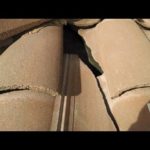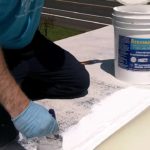INSTAGRAM:http://instagram.com/robesondesignteam Sign up for our DESIGN SESSIONS here! http://bit.ly/designsessionssignup This is the second episode for the Del Mar house reveal. And this…
Lead and Flat Roof Repair – Stop Flat Roof Leaks

http://www.fixmyroof.co.uk/videos-and-guides/bay-window-roof/lead-bay-roof/ This video shows probably the best and easiest way to achieve a long lasting repair to most lead work on a roof….
roof leak repair NJ
Bathroom Flooring Options: Counting From the Worst to the Best Choices
When selecting the right construction material for your bathroom floor, you are faced with the same considerations as when selecting flooring materials for other areas in the house. Is your roofing durable? Will it withstand the kids’ activities? Does it feel good under bare feet? Here are some of the top flooring options from the worst to best.
No. 7: Carpet. A carpet can be a bad choice for bathroom floors. Just like water and oil, carpet and moisture are not the best of friends either. If you still insist on having carpet in your bathroom, make sure to take a look at pointers and tips from professional carpet installers.
No. 6: Solid hardwood. It may not be the best choice but it is slightly a better option compared to carpet flooring. Solid hardwood looks nice and feels warm under bare feet. But the major disadvantage for this kind of flooring is that moisture destroys the hardwood. If you still want solid hardwood bathroom flooring, make sure the tiles are perfectly installed without gaps to make no room for moisture to thrive in. For this bathroom remodeling project, it would be advisable that you hire the services of a professional installer to help you save money in the long run.
No. 5: Laminate Flooring. In general, laminate flooring is a viable choice for bathrooms. This kind of flooring is a better choice compared to solid hardwood. Laminate flooring is generally a resin impregnated paper that is placed atop wood chip base. The laminate plank’s surface is actually a picture of whatever it is supposed to be imitating- can be slate, marble, oak or cherry. On its uppermost surface is the part that manufacturers tag as the ‘wear layer’. This is a clear layer of melamine and is proven to be very strong. The seams are usually glued together so it is hard for moisture to work its way down the tiles. Laminate is also easy to clean but make sure you keep it away from too much moisture or it will expand and bubble.
No. 4: Engineered Wood. This type has a plywood base that holds up pretty good against moisture. It also looks great since its topmost layer is made up of real wood. If you choose the wood floor look in your bath, engineered wood is a great option.
No. 3: Stone. You don’t have to deal with moisture problems if you choose limestone, granite, marble and other stone flooring options. Stone does not make it to the top list because it can get slippery especially when wet. Stone floors will get a huge budget allocation of any bathroom remodeling project.
No. 2: Tile or Sheet Vinyl. Vinyl is perhaps the most popular option for bathroom floors. it features easy flooring installation and is available in a wide variety of styles, colors and designs.
No. 1: Ceramic Tile. Just like stone, ceramic tiles offer that solid and textured feeling. It is also waterproof and can be fairly expensive. And just like your wood floors, it looks pretty nice. There are different types of ceramic tiles and you should exactly get the type of flooring you want. Like stone, it can be cold and slippery. But texturing will help solve this problem. Go for smaller tiles for enhanced safety.
Metal Roof Repair – Metal Over Metal Using Roof Hugger

Metal roof repair video explains how to recover your existing metal roof with a new standing seam metal roofing using Roof hugger. The roof hugger system is a sub-framing member that installs…
roofing repair NJ
SUBNAUTICA – INTERIOR DESIGN! : Ep.14 (Subnautica Full Release)
SUBNAUTICA – INTERIOR DESIGN! : Ep.14 Don’t forget to leave a LIKE on this video for more! Subscribe for more! ▻ http://goo.gl/yCQnEn ▻ Subnautica Playlist : https://goo.gl/vnEsNK ▻…
Home repair roof tile broken by froggy

Home repair roof tile broken by froggy Thanks for 1 million views! Attempt all work at your own risk. The publisher bears no responsibility for improper or unsafe repairs, injury, or damages…
NJ roofers
Choosing Discount Hardwood Flooring
If you've priced hardwood flooring and feel you'll never be able to afford the elegant floors that you want for your home, now's the time to take heart. There may be a way that you can reconcile your dreams with your budget, and that's by looking for discount hardwood flooring. Although there are some really cheap wood flooring materials on the market, those are not what we're looking here. We're talking about real, solid hardwoods at great prices. This is flooring you can use anywhere in your home where it can be nailed or stapled to the existing floor or laid over a concrete floor. You'll be able to give all the rooms in your home an awesome new look without resorting to cheaper laminates or breaking your bank account.
Some discount floors have sliced wood veneer which will give you the same designs and colors that you can get with solid hardwoods. The veneer on these floors is applied to solid hardwood backings to give the floor durability. You will also be able to find laminate floors designed to look like hardwoods that will last just as long as solid hardwoods do, because they are also made using hardwood backings. Since hardwoods are known for expanding and contracting well in heat and cold, this makes the discount floors suitable for use in all climates.
Even though discount flooring is less expensive to buy, it is still manufactured to exacting standards. For example, all cheap hardwood flooring is precision-spaced to allow for flexibility in the planks. This is done by taking an aluminum tube and stamping it onto each piece of laminate flooring precisely 1.5 mm apart.
Discount hardwoods come in both pre-finished and unfinished woods. Although many people prefer pre-finished flooring, because they do not want the big job of finishing it, others prefer to finish their floors their own way and opt for the unfinished type. There are many wood choices in discount flooring as well as a variety of different stains so that you can have the floor that will perfectly accent the decor in your home. While you will not have a choice of pre-finished or unfinished with laminate flooring, you will still be able to choose from many different colors.
In this world of increasing costs, decreasing spending power, and the threat of foreclosures, homeowners everywhere are looking for bargains in materials to renovate their homes. Discount hardwood floors and laminates are becoming popular options since they look great for less cost. Laminate flooring is made by putting a piece of fiberboard between two pieces of melamine. It will give you the look of hardwoods at a fraction of the cost. You will also be able to find discount hardwoods that have been embossed in the factory to give them a texture like the grain of real wood. Your floors will look gorgeous, and no one will ever know that you got them at a discount.
RV Rubber Roof Restoration and Repair

Rexoseal RV is a high build white acrylic elastomeric, liquid applied topcoat designed to cure to form a highly elastic seamless, long lasting protective barrier.
roofing contractors nj
Uchaneram- Interior Designer
ACV or Asianet Cable Vision is a cable TV channel in Kerala that is part of Asianet Satellite Communications Ltd., the largest cable network services and broadband internet company in Kerala….
Flooring: How to Calculate How Much Tile You Need
With some simple measuring and calculating, you can determine how much tile you need for your flooring project. If you are shopping for tile, this will help you get a handle on much the materials will cost you. If you are hiring an installer to do the project for you, you can provide the room measurements as well, to obtain an installation price quote-although the installer typically comes out to take their own measurements.
Supplies:
Paper
Pen or Pencil
Measuring Tape
Calculator (optional)
Step 1
Measure the length of the room or the floor area where you are tiling.
Step 2
Measure the width of the room or the floor area where you are tiling.
Step 3
Multiply the length of the floor by the width of the floor to determine the square footage of the room. For example, if the room is 12 feet wide by 12 feet long, then you would multiply 12 by 12 to get 144 square feet.
Step 4
Add 15% to the square footage. You should also add 15% to the amount of tile you need in order to accommodate for cuts, waste and breaks during installation. In addition, you want to have extra tile after the project is finished in case you have future problems such as cracks or broken tiles. Also, the tile may go out of the stock, so if you do not have extra tile, you may not be able to replace the broken or cracked tiles.
Step 5
Calculate how many boxes of tile you need. Divide the square footage of the room by the total square footage of tile in the box. For example, if the box has 10 square feet of tile, then you would need 15 boxes of tile.
Tips
A good rule of thumb: If you do not have at least one box of tiles left when your floor is in then buy one additional box to keep in storage.
If you are installing a diagonal or diamond pattern, then you should buy at least 20% in extra tile than if you are laying a square or straight tile floor pattern.


